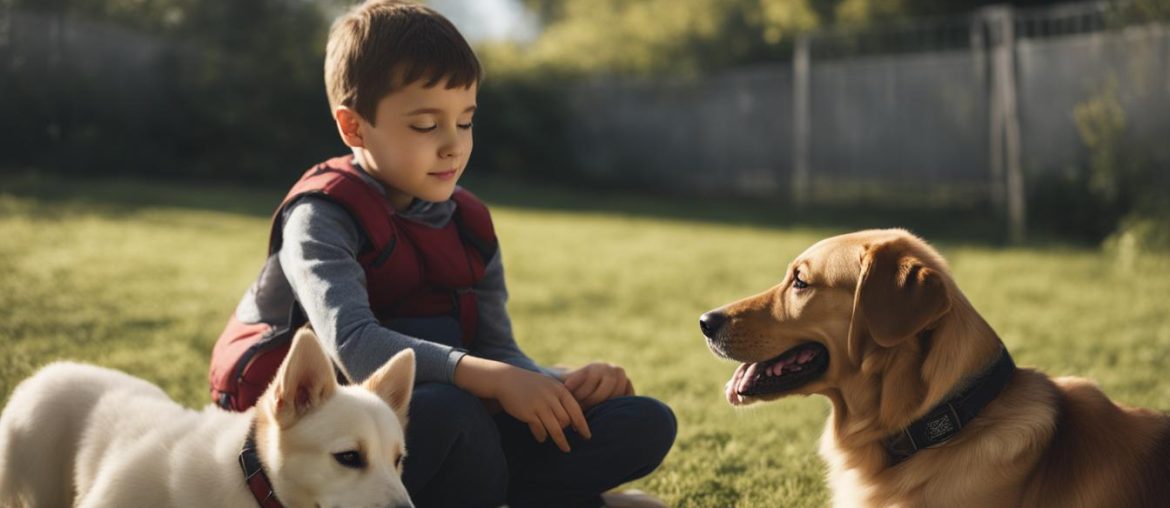Autistic children can find incredible companionship and support in dogs. Whether it’s a service dog, therapy dog, or companion dog, finding the right canine partner can make a world of difference. In this article, I will explore the different types of dogs that are suitable for autism and provide guidance on choosing the best breed for your child. From Golden Retrievers to Labrador Retrievers, we’ll uncover the top breeds that excel in supporting autistic individuals. Additionally, I’ll discuss the benefits of dogs for autistic children, the training and care required, and the impact these furry friends can have on their lives. So, join me on this journey as we explore the wonderful world of dogs and autism.
Key Takeaways:
- The best dogs for autism include Golden Retrievers, Labrador Retrievers, and other breeds known for their outgoing personalities and loyalty.
- Dogs provide a range of benefits for autistic children, including improved social skills, reduced anxiety, and assistance with specific tasks.
- Service dogs, therapy dogs, and companion dogs each offer unique support and should be chosen based on the individual needs of the child.
- Training and caring for autism dogs require specialized techniques and approaches tailored to the needs of individuals on the spectrum.
- Dogs can have a profound impact on the lives of autistic children, providing companionship, emotional support, and promoting empathy and compassion.
Benefits of Dogs for Autistic Children
Autistic children can greatly benefit from having dogs as companions. Dogs offer a range of advantages that contribute to the well-being and development of these children. Here are some key benefits:
- Social abilities: Dogs can help improve social skills in autistic children. Interacting with a dog can teach them about non-verbal communication, empathy, and building relationships.
- Emotional support: Dogs provide unconditional love and emotional support, which can be particularly beneficial for autistic children who may struggle with emotional regulation.
- Anxiety reduction: Dogs have a calming effect on autistic children and can help reduce anxiety and stress. They provide a sense of security and comfort, promoting a positive and relaxed environment.
- Specific tasks: Dogs trained for autism can assist with specific tasks, such as tracking and locating children who tend to wander off and intervening in cases of self-harm. These tasks enhance the safety and well-being of autistic children.
- Motivation and confidence: Interacting with a dog can increase a child’s motivation and confidence. Dogs are non-judgmental and provide a safe space for children to practice and develop their skills.
- Motor abilities: Activities such as walking or playing with a dog can enhance the motor abilities of autistic children. These physical interactions contribute to their overall physical development.
“The presence of a dog can create a positive and calming atmosphere for children with autism.”
training dogs for autism requires specific techniques and strategies that cater to the unique needs of individuals on the spectrum. Professional trainers with experience in working with autism dogs can provide the necessary guidance and expertise in this area.

The Benefits of Dog-Assisted Therapy for Autistic Children
In addition to the general benefits of having a dog, dog-assisted therapy has been proven to be highly effective for autistic children. In this therapy, specially trained dogs work alongside therapists to support children’s emotional, cognitive, and social development.
Research has shown that dog-assisted therapy can:
- Improve communication and language skills
- Enhance empathy and social interactions
- Reduce anxiety and improve emotional regulation
- Stimulate sensory processing and integration
The presence of a therapy dog creates a nurturing and supportive environment where autistic children can feel comfortable exploring and developing various skills. The bond between the child and the dog serves as a catalyst for growth and progress in therapy sessions.
Training Autism Assistance Dogs
| Task | Assistance Provided |
|---|---|
| Tracking and Locating | Helping find children who wander off or get lost |
| Intervention | Interrupting and redirecting self-harming behaviors |
| Anxiety and Meltdown Support | Providing comfort and grounding during meltdowns |
| Sensory Support | Assisting with sensory processing and integration |
Training autism assistance dogs involves teaching them specific tasks that directly support and meet the needs of autistic individuals. These tasks can include:
- Tracking and locating children who may wander off or get lost
- Intervening in self-harming behaviors by interrupting and redirecting the child’s focus
- Providing comfort and support during anxiety and meltdown episodes
- Assisting with sensory processing and integration
By performing these tasks, autism assistance dogs contribute to the safety, well-being, and overall development of autistic individuals.
Choosing the Right Breed for Your Autistic Child
When it comes to choosing a dog breed for an autistic child, several factors should be taken into consideration. I highly suggest that you find a breed that matches the child’s physical and emotional skills, as well as their individual needs and sensitivities. Golden Retrievers, Labrador Retrievers, Standard Poodles, Staffordshire Bull Terriers, and German Shepherds are popular choices for autism, known for their gentle nature, sociability, and trainability.
However, evaluate each dog’s temperament and compatibility with the child before making a decision. A good way to do this is by visiting local kennels and interacting with different breeds, observing their reactions, and assessing their suitability for your child. This hands-on approach can help ensure the best match between your child and their furry companion.
Factors to Consider when Choosing a Breed
- Temperament: Look for breeds known for their calm and gentle nature, as well as their sociability and compatibility with children.
- Trainability: Choose a breed that is easily trainable, as this will be important for your child’s safety and for the dog to fulfill its role as a companion.
- Size and Energy Level: Consider the size and energy level of the breed, taking into account the space available in your home and the level of physical activity your child can comfortably handle.

To put it simply, every child is unique, and what works for one child may not work for another. Take the time to research and understand the characteristics of each breed and how they align with your child’s needs and preferences. Consulting with professionals who have experience working with autistic children and dogs can also provide valuable guidance and support in choosing the right breed.
Service Dogs for Autism
Service dogs play a vital role in assisting individuals with autism and providing them with the support they need. These highly trained dogs undergo extensive training to carry out specific tasks that can help autistic individuals navigate their daily lives. From tracking and locating children who tend to wander off to intervening in self-harm situations, service dogs can be a lifeline for those on the autism spectrum.
There are several organizations that specialize in training and placing service dogs for autism. These organizations work tirelessly to ensure that each dog is well-trained and equipped to meet the unique needs of the individual they will be assisting. Some notable organizations include 4 Paws for Ability, Autism Service Dogs of America, and Assistance Dogs International. These organizations offer high-quality training and ongoing support to both the dog and the individual with autism.
Service dogs for autism go through rigorous training programs that focus on obedience, task-specific skills, and responding to cues. They are trained to provide emotional support and assistance in various situations, helping to alleviate anxiety and meltdowns. The presence of a service dog can provide a sense of security, independence, and companionship for individuals with autism, ultimately improving their quality of life.
Benefits of Service Dogs for Autism
- Track and locate children who tend to wander off
- Intervene in self-harm situations
- Provide emotional support and reduce anxiety
- Alleviate meltdowns and promote emotional regulation
- Enhance independence and social interactions
Service dogs for autism offer a wide range of benefits for individuals on the spectrum. These dogs can track and locate children who have a tendency to wander off, ensuring their safety and providing peace of mind for parents and caregivers. In situations where self-harm may occur, service dogs can intervene and provide comfort, keeping the individual safe.
Emotionally, service dogs for autism offer significant support. They can provide comfort during meltdowns, helping to regulate emotions and reduce anxiety levels. The presence of a service dog can also improve social interactions, as these dogs often serve as a bridge between the autistic individual and others, leading to increased social confidence and communication skills.
Overall, service dogs for autism are invaluable companions and assistants for individuals on the spectrum. Their unique training and abilities make them an essential part of the autism community, providing support, comfort, and independence to those who need it most.
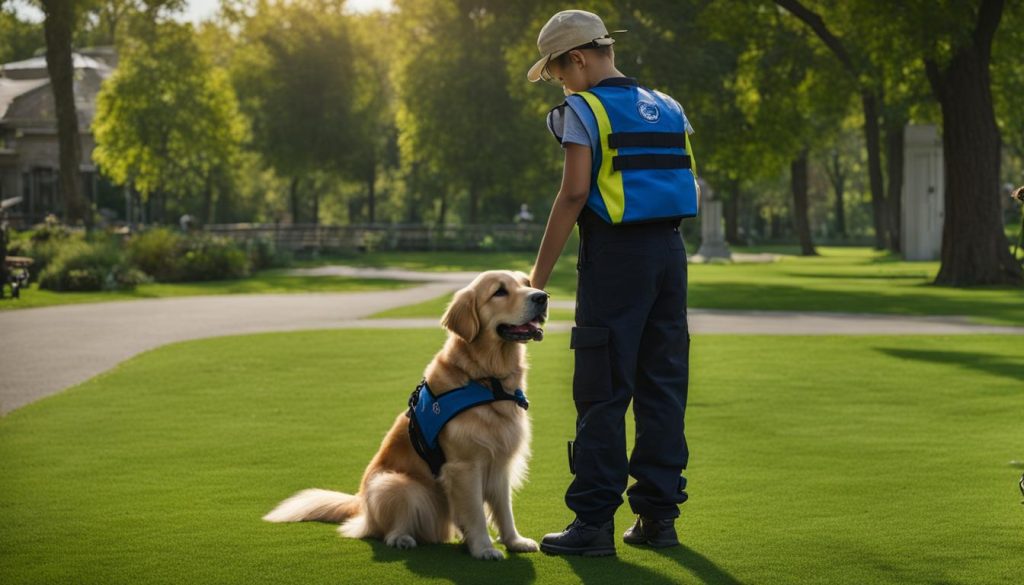
Therapy Dogs for Autism
Therapy dogs play a crucial role in providing emotional support and companionship to individuals with autism. These specially trained dogs are not tasked with performing specific tasks but focus on offering comfort and improving the overall well-being of autistic individuals. Interacting with therapy dogs has been shown to help improve social skills, reduce stress and anxiety, and provide a calming presence for those on the autism spectrum.
Therapy dogs for autism are trained to be gentle, patient, and responsive to the needs of individuals with autism. They can help create a positive and nurturing environment in therapy sessions, allowing for increased engagement and participation in various therapeutic activities. The presence of therapy dogs can also help build trust and rapport between the therapist and the autistic individual, facilitating the therapeutic process.
Many organizations offer therapy dog programs specifically designed for individuals with autism. These programs often involve thorough training and certification processes to ensure that therapy dogs are well-equipped to provide the necessary support and therapy. Examples of such organizations include Canine Companions for Independence and Custom Canines Service Dog Academy.
The Benefits of Therapy Dogs for Autism
Therapy dogs for autism offer a range of benefits for individuals on the spectrum. Here are some of the key advantages:
- Improved Social Skills: Interacting with therapy dogs can help individuals with autism develop and enhance their social skills, such as initiating and maintaining eye contact, recognizing and interpreting social cues, and engaging in reciprocal communication.
- Reduced Anxiety and Stress: The presence of therapy dogs has a calming effect on individuals with autism, helping to reduce anxiety and stress levels. The dogs provide comfort and reassurance during challenging situations or transitions.
- Increased Emotional Well-being: Therapy dogs offer unconditional love, companionship, and emotional support, which can positively impact the emotional well-being of individuals with autism. The bond formed with therapy dogs can provide a sense of security and belonging.

Table: Comparison of Therapy Dogs for Autism Programs
| Organization | Training Duration | Certification Process | Availability |
|---|---|---|---|
| Canine Companions for Independence | Approximately 2 years | Requires passing an evaluation and completing a team training program | Nationwide availability |
| Custom Canines Service Dog Academy | Variable depending on the specific program | Requires passing evaluations and completing training milestones | Available in selected regions |
Companion Dogs for Autism
Companion dogs are a popular choice for providing support and companionship to individuals with autism. These dogs offer emotional support and can help improve social skills and overall well-being. Labradoodles, Poodles, and Beagles are among the breeds commonly used as companion dogs for children with autism.
Companion dogs play a vital role in providing comfort and stability to autistic children. They can help reduce anxiety and provide a calming presence during meltdowns or stressful situations. These dogs are not specifically trained for tasks but offer emotional support and unconditional love to their owners.
When choosing a companion dog for an autistic child, you should consider compatibility and temperament. Each child is unique, and it is essential to find a dog that matches the child’s needs and sensitivities. By visiting local kennels and interacting with different breeds, parents can observe the dogs’ reactions and choose the best companion for their child.
“Companion dogs for autism provide emotional support and companionship to children with autism, helping to improve their social skills and overall well-being.”
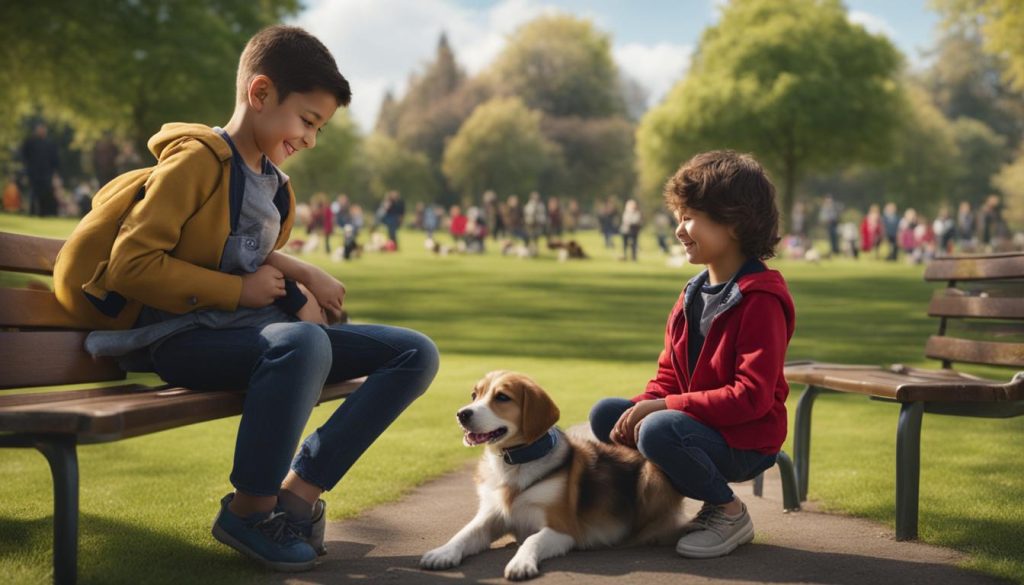
| Breed | Traits |
|---|---|
| Labradoodle | Intelligent, friendly, hypoallergenic |
| Poodle | Active, obedient, hypoallergenic |
| Beagle | Loving, friendly, small size |
Companion dogs require proper training and socialization to ensure they can adapt to the needs of autistic children. Building a strong bond between the child and the dog is crucial for a successful partnership. Regular exercise, veterinary care, and a loving environment are essential for the well-being of companion dogs. By providing emotional support and companionship, these dogs can enhance the lives of children with autism and contribute to their overall development.
Training and Care for Autism Dogs
Training and caring for autism dogs require specialized techniques and approaches to meet the unique needs of individuals on the spectrum. Effective training focuses on obedience, socialization, and task-specific skills that can benefit the autistic child. Working with professional trainers who understand the challenges of training autism dogs is crucial for success.
“Training autism dogs requires patience, consistency, and positive reinforcement. You should tailor training methods to suit the specific needs and sensitivities of the individual child. By using rewards and praise, we can encourage desired behaviors and help the dog develop the necessary skills to assist their handler.”
— Professional Dog Trainer
Caring for autism dogs involves creating a loving and nurturing environment. Regular exercise, proper nutrition, and routine veterinary check-ups are essential for their well-being. Additionally, grooming and hygiene practices help maintain their health and comfort. Establishing a consistent routine and structure provides stability for both the dog and the autistic child.
Furthermore, ongoing support and education are important for the long-term care of autism dogs. Regular follow-up sessions with trainers can help address any behavioral changes or challenges as the dog assists the child in various situations. Providing a safe and stimulating environment that caters to the dog’s physical and mental needs is vital for their overall happiness and well-being.
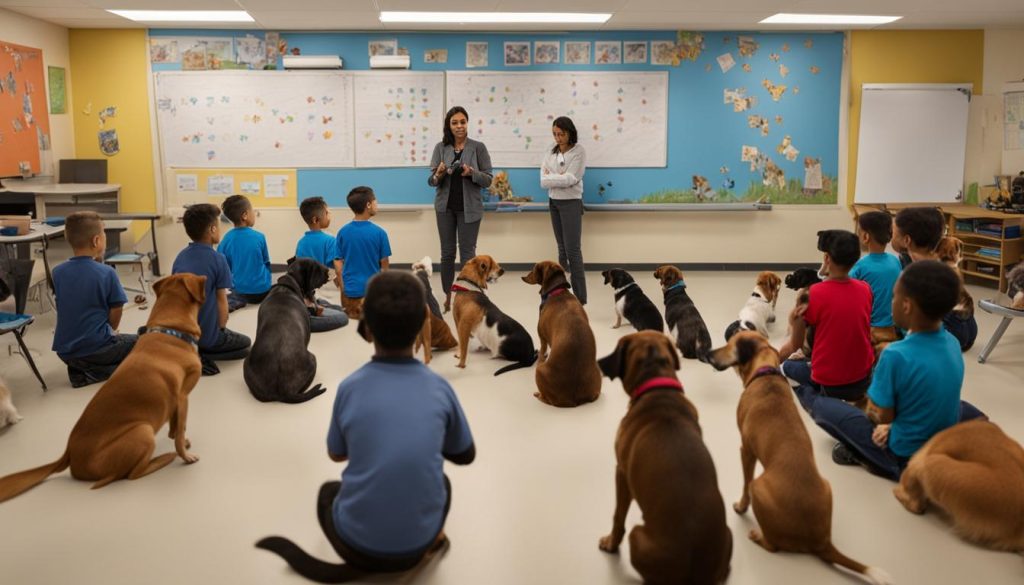
Training Techniques for Autism Dogs
When training autism dogs, I would advise that you use positive reinforcement methods, such as rewards and praise. These techniques create a positive association with desired behaviors and motivate the dog to continue learning. Additionally, breaking tasks into smaller, manageable steps and providing clear instructions help the dog understand and execute commands more effectively.
Socialization is another crucial aspect of training for autism dogs. Exposing them to different environments, people, and situations helps them adapt to various scenarios they may encounter while assisting their handler. Gradual exposure and positive experiences build the dog’s confidence and reduce anxiety.
| Training Techniques for Autism Dogs | Benefits |
|---|---|
| Positive reinforcement | Creates a positive association with desired behaviors |
| Breaking tasks into smaller steps | Facilitates learning and comprehension |
| Socialization | Helps dogs adapt to different environments and reduce anxiety |
Training autism dogs requires dedication, patience, and a deep understanding of the individual child’s needs. With the right approach and ongoing support, these pretty good dogs can make a significant difference in the lives of autistic children.
The Impact of Dogs on Autistic Children
When it comes to assisting autistic children, dogs play a vital role in improving their lives. The presence of a dog can have a significant impact on the emotional well-being and overall development of these children. Dogs offer companionship, unconditional love, and a source of comfort that can greatly benefit autistic individuals.
One of the key benefits of dogs for autistic children is their ability to improve social skills. Interacting with a dog can help promote communication, empathy, and social interaction in a non-judgmental and safe environment. As autistic children form strong bonds with dogs, they learn to understand and care for the needs of their furry companions, which can translate into improved social interactions with humans.
“Dogs provide comfort, companionship, and emotional support to autistic children, and can help reduce anxiety and stress.”
In addition to enhancing social skills, dogs can also help reduce anxiety and stress in autistic children. The calming presence of a dog can help regulate emotions and provide a sense of security and well-being. Dogs are often used as therapy animals for autism, as their presence and interactions have been shown to have a positive impact on emotional regulation and overall mental health.
Furthermore, dogs can assist in the development of sensory integration skills in autistic children. Their touch, smell, and sound can stimulate sensory experiences and help children become more aware of their surroundings. This interaction with dogs can contribute to the overall sensory development and integration of autistic children.
| Benefits of Dogs for Autistic Children |
|---|
| Improvement in social skills |
| Reduction of anxiety and stress |
| Enhancement of sensory integration skills |
Dogs have a profound impact on the lives of autistic children. They provide emotional support, assist in social skill development, and help reduce anxiety and stress. These furry companions can make a significant difference in the well-being and overall quality of life for autistic individuals.
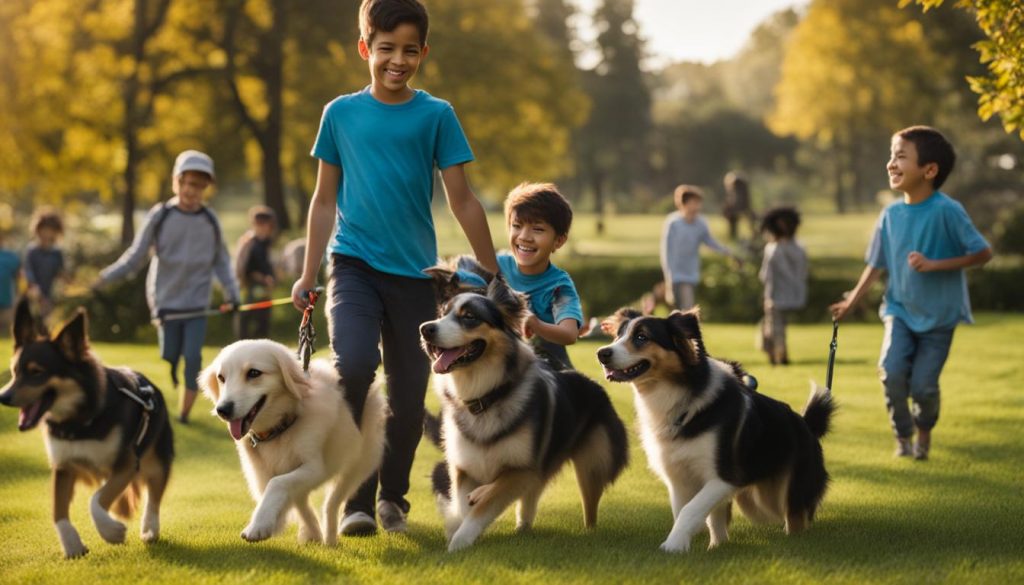
Tips for Introducing a Dog to an Autistic Child
Introducing a dog to an autistic child can be a rewarding and beneficial experience, but approach the process with careful planning and preparation. Each child is unique, and their sensitivities and preferences must be taken into consideration to ensure a successful introduction. Here are some tips to help make the transition smoother:
- Gradual Introductions: Start by gradually introducing the dog to the child in a controlled and supervised environment. Allow the child to observe the dog from a distance and gradually decrease the distance over time. This will help the child become familiar with the dog’s presence without feeling overwhelmed.
- Patient and Positive Reinforcement: Encourage the child to interact with the dog at their own pace. Use positive reinforcement techniques, such as praise and rewards, to reinforce positive interactions and help the child feel comfortable and confident around the dog.
- Sensory Considerations: Take into account the child’s sensory sensitivities when choosing a dog. Consider factors such as the dog’s size, energy level, and grooming requirements to ensure compatibility with the child’s sensory preferences.
- Professional Guidance: Seek guidance from professionals who have experience working with both autistic children and dogs. Therapists or dog trainers can provide valuable insights and strategies for introducing the dog to the child in a way that promotes a positive and safe relationship.
To put it simply, each child-dog introduction is unique, and it may take time for the child and the dog to develop a bond. Patience, consistency, and ongoing supervision are key to fostering a successful and rewarding relationship between the autistic child and their new furry friend.

Testimonials:
“Introducing our dog to our autistic son was a gradual process, but it has made a tremendous difference in his life. The dog has become his constant companion and has helped him improve his social skills and reduce anxiety.” – Sarah, parent of an autistic child.
“We consulted with a therapist who specialized in autism and dogs before introducing our new pup to our daughter. The professional guidance and strategies provided were invaluable in ensuring a smooth and positive introduction. The dog has become an important part of our daughter’s therapy and has brought so much joy into her life.” – Mark, parent of an autistic child.
| Benefits of Introducing a Dog to an Autistic Child | Tips for Introducing a Dog to an Autistic Child |
|---|---|
| 1. Provides companionship and emotional support | 1. Gradually introduce the dog in a controlled environment |
| 2. Helps improve social skills and reduce anxiety | 2. Use positive reinforcement and patience |
| 3. Promotes a sense of responsibility and empathy | 3. Consider the child’s sensory sensitivities |
| 4. Enhances therapy outcomes and provides a calming presence | 4. Seek professional guidance |
The Role of Dogs in Autism Therapy
Dogs play a crucial role in autism therapy and support, providing a range of benefits to individuals with autism. They serve as co-therapists, offering a non-judgmental and safe environment for practicing and developing social and emotional skills. Dogs can assist in various therapy techniques, including social skills training, emotional regulation, and sensory integration, making therapy sessions more effective and impactful.
According to a study by Smith et al., the presence of a therapy dog during therapy sessions increased positive behaviors and engagement in children with autism. The dogs helped to create a calm and nurturing environment, reducing anxiety and stress. The tactile stimulation provided by petting and interacting with the dogs also contributed to sensory integration and regulation for autistic individuals.
“Having a therapy dog in the therapy room has been transformative for my clients with autism. The dogs provide comfort and support, helping the children feel safe and more open to exploring their feelings and challenges.” – Dr. Sarah Johnson, Licensed Therapist
In addition to the emotional and sensory benefits, dogs in autism therapy can also assist in tasks such as tracking and locating children who tend to wander off, alerting to self-harm behaviors, and providing comfort during meltdowns. The presence of a dog can significantly enhance the overall therapy experience, promoting positive outcomes and improvements in social, emotional, and cognitive functioning for individuals on the autism spectrum.

Table: Comparison of Dogs in Autism Therapy
| Breed | Key Benefits | Training Focus |
|---|---|---|
| Golden Retriever | Unconditional love, emotional support, tracking and locating | Therapy and obedience training |
| Labradoodle | Reducing anxiety, sensory integration, emotional regulation | Therapy and socialization training |
| German Shepherd | Alerting to self-harm behaviors, providing comfort during meltdowns | Assistance and obedience training |
When considering the use of dogs in autism therapy, work with professionals who have experience and expertise in this field. These professionals can provide guidance on selecting the right breed and individual dog for therapy sessions, as well as offer training advice and techniques tailored to the specific needs of individuals with autism.
The positive impact of dogs in autism therapy is evident, with many individuals experiencing improved social skills, emotional well-being, and overall quality of life. The presence of a well-trained and compatible therapy dog can make a significant difference in the therapy journey for individuals with autism, fostering growth, connection, and positive therapeutic outcomes.
Additional Support for Autistic Children
While dogs can provide valuable support for autistic children, consider additional support resources to ensure comprehensive care and assistance. Here are some autism support resources that can help:
- Therapies: Applied Behavior Analysis (ABA) therapy and occupational therapy can address specific challenges and promote skill development in autistic children. These evidence-based therapies use structured interventions to improve communication, social skills, and daily living activities.
- Support groups and online communities: Joining support groups and online communities can provide parents and caregivers of autistic children with valuable information, advice, and support. These communities offer a platform to connect with others facing similar experiences, share experiences, and exchange knowledge about available resources.
- Educational resources: Accessing educational resources specific to autism can help parents and caregivers gain a deeper understanding of their child’s condition and learn effective strategies for supporting their development. Books, websites, and online courses provide valuable insights into autism and offer practical tips for managing everyday challenges.
- Collaboration with professionals: Working closely with healthcare professionals, educators, therapists, and behavior specialists can ensure a holistic approach to support the needs of autistic children. These professionals can provide guidance, develop personalized intervention plans, and offer ongoing monitoring to track progress and make necessary adjustments.
By combining the support of dogs with these additional resources, parents and caregivers can create a well-rounded and tailored support system for their autistic child.

Building a Community of Support
As a parent or caregiver of an autistic child, please build a community of support. Reach out to local organizations, autism centers, and advocacy groups to connect with other families facing similar challenges. Participate in workshops, seminars, and conferences to stay updated on the latest research and techniques in autism care. To put it simply, you are not alone in this journey, and there are many resources available to help you provide the best possible support for your child.
Empowering Autistic Individuals
While it’s important for parents and caregivers to provide support, it’s equally important to empower autistic individuals themselves. Encourage self-advocacy and self-expression by providing opportunities for decision-making and fostering independence. Celebrate their strengths and accomplishments, and create an environment that values their unique perspectives and abilities. By empowering autistic individuals, we can help them thrive and contribute to society in meaningful ways.
Final Thoughts
In conclusion, dogs can play a crucial role in the lives of autistic children, providing them with emotional support, companionship, and assistance in various ways. When selecting a dog for an autistic child, you should consider their individual needs and sensitivities, as well as the specific traits and characteristics of different breeds.
Golden Retrievers, Saint Bernards, Labradoodles, and German Shepherds are among the top recommended breeds for autism, known for their outgoing personalities, loyalty, and trainability. Service dogs, therapy dogs, and companion dogs each offer unique benefits and can be chosen based on the specific needs and requirements of the child.
Professional training, proper care, and ongoing support are essential to ensure the well-being and success of autism dogs. By providing a loving and structured environment, autistic children can form strong bonds with their furry companions, leading to improved social skills, reduced anxiety and stress, and an overall sense of security and well-being. The presence of a dog can create a positive and calming atmosphere for children with autism, enhancing their communication and interaction skills.
In summary, the right dog can make a significant difference in the life of an autistic child, offering them companionship, emotional support, and the assistance they need. By selecting the best breed and providing proper training and care, families can create a positive and nurturing environment for their child’s development and well-being.
FAQ
What are the best breeds of dogs for autism?
Some of the top breeds for autism include Golden Retrievers, Saint Bernards, Labradoodles, Collies, German Shepherds, and Bernese Mountain Dogs.
What are the benefits of dogs for autistic children?
Dogs can improve social abilities, provide emotional support, reduce anxiety, assist with specific tasks, and help ground autistic children.
What is the difference between service dogs, therapy dogs, and companion dogs for autism?
Service dogs are trained to perform specific tasks, therapy dogs provide emotional support, and companion dogs offer companionship and emotional support without specific training.
Are there organizations that train and provide service dogs for autism?
Yes, some organizations that specialize in training and providing service dogs for autism include 4 Paws for Ability, Autism Service Dogs of America, and Canine Companions for Independence.
How do I choose the right breed for my autistic child?
I recommend that you consider the child’s needs, sensitivities, and the dog’s temperament, trainability, and compatibility with the child’s physical and emotional skills.
What is the role of service dogs for autism?
Service dogs for autism can assist with specific tasks such as tracking and locating children, intervening in self-harm situations, and providing support during anxiety and meltdowns.
How do therapy dogs help children with autism?
Therapy dogs provide emotional support, improve social skills, and offer a calming presence for autistic individuals.
What is the role of companion dogs for autism?
Companion dogs offer affection, friendship, and emotional support to autistic children, improving social skills and providing comfort during meltdowns.
How should autism dogs be trained and cared for?
Autism dogs require specific training techniques focused on obedience, socialization, and task-specific skills. They also need a loving environment, regular exercise, proper nutrition, veterinary check-ups, and grooming.
What is the impact of dogs on autistic children?
Dogs provide companionship, emotional support, and can enhance social skills, empathy, and communication for autistic children.
What are tips for introducing a dog to an autistic child?
Gradual introductions, supervised interactions, and seeking guidance from professionals can help ease the transition and establish a positive relationship between the child and the dog.
What is the role of dogs in autism therapy?
Dogs can assist in various therapy techniques, provide a safe and nurturing environment, and offer comfort and support during therapy sessions for autistic individuals.
What additional support is available for autistic children?
Therapies, support groups, online communities, and educational resources can provide valuable support for parents, caregivers, and autistic children.


